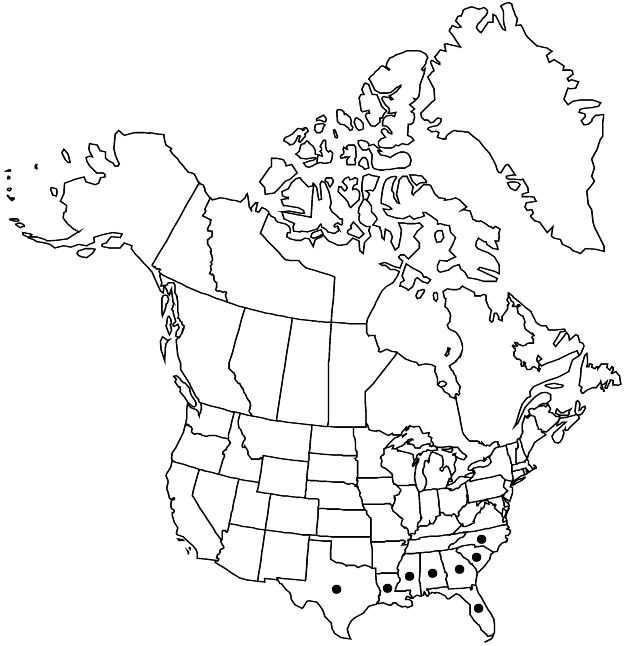Difference between revisions of "Croton punctatus"
Collectanea 1: 166. 1787.
FNA>Volume Importer |
FNA>Volume Importer |
||
| Line 12: | Line 12: | ||
|name=Croton disjunctiflorus | |name=Croton disjunctiflorus | ||
|authority=Michaux | |authority=Michaux | ||
| − | }}{{Treatment/ID/Synonym | + | }} {{Treatment/ID/Synonym |
|name=C. maritimus | |name=C. maritimus | ||
|authority=Walter | |authority=Walter | ||
| − | }}{{Treatment/ID/Synonym | + | }} {{Treatment/ID/Synonym |
|name=C. plukenetii | |name=C. plukenetii | ||
|authority=Geiseler | |authority=Geiseler | ||
| Line 33: | Line 33: | ||
|elevation=0–20 m. | |elevation=0–20 m. | ||
|distribution=Ala.;Fla.;Ga.;La.;Miss.;N.C.;S.C.;Tex.;e Mexico;West Indies;Central America;n South America. | |distribution=Ala.;Fla.;Ga.;La.;Miss.;N.C.;S.C.;Tex.;e Mexico;West Indies;Central America;n South America. | ||
| − | |discussion=<p>A report of Croton punctatus from Pennsylvania apparently was based on a transient appearance on ballast (E. T. Wherry et al. 1979).</p> | + | |discussion=<p>A report of <i>Croton punctatus</i> from Pennsylvania apparently was based on a transient appearance on ballast (E. T. Wherry et al. 1979).</p> |
|tables= | |tables= | ||
|references= | |references= | ||
| Line 57: | Line 57: | ||
|publication year=1787 | |publication year=1787 | ||
|special status= | |special status= | ||
| − | |source xml=https://jpend@bitbucket.org/aafc-mbb/fna-data-curation.git/src/ | + | |source xml=https://jpend@bitbucket.org/aafc-mbb/fna-data-curation.git/src/8f726806613d60c220dc4493de13607dd3150896/coarse_grained_fna_xml/V12/V12_13.xml |
|genus=Croton | |genus=Croton | ||
|species=Croton punctatus | |species=Croton punctatus | ||
Revision as of 14:43, 18 September 2019
Shrubs, 3–10 dm, monoecious or sometimes appearing dioecious. Stems trichotomously branching, stellate-hairy to stellate-lepidote. Leaves not clustered; stipules absent; petiole 1–4 cm, 1/2 to equal blade length, glands absent at apex; blade broadly elliptic to suborbiculate, 2–5 × 1.5–4 cm, much less than 2 times as long as wide, base rounded to truncate, margins entire, apex obtuse to rounded, abaxial surface pale grayish green, stellate-lepidote, adaxial surface slightly darker green, stellate-lepidote. Inflorescences unisexual or bisexual, racemes, 1–4 cm, staminate flowers 3–7, pistillate flowers 1–3. Pedicels: staminate 2–4 mm, pistillate 0–1 mm. Staminate flowers: sepals 5–6, 2.5 mm, abaxial surface stellate-lepidote; petals 0; stamens 10–13. Pistillate flowers: sepals 5, equal, 3–3.5 mm, margins entire, apex incurved, abaxial surface stellate-lepidote; petals 0; ovary 3-locular; styles 3, 1–2 mm, multifid, terminal segments 12–24. Capsules 5–8 × 7–9 mm, smooth; columella 3-winged. Seeds 4.5–6 × 3.7–4.5 mm, dull. 2n = 28.
Phenology: Flowering year-round.
Habitat: Beaches, dunes.
Elevation: 0–20 m.
Distribution

Ala., Fla., Ga., La., Miss., N.C., S.C., Tex., e Mexico, West Indies, Central America, n South America.
Discussion
A report of Croton punctatus from Pennsylvania apparently was based on a transient appearance on ballast (E. T. Wherry et al. 1979).
Selected References
None.